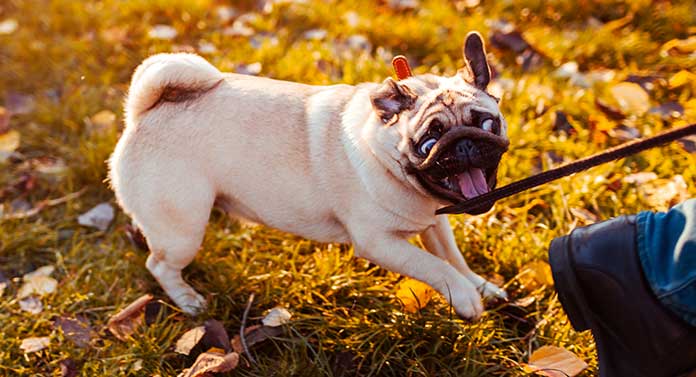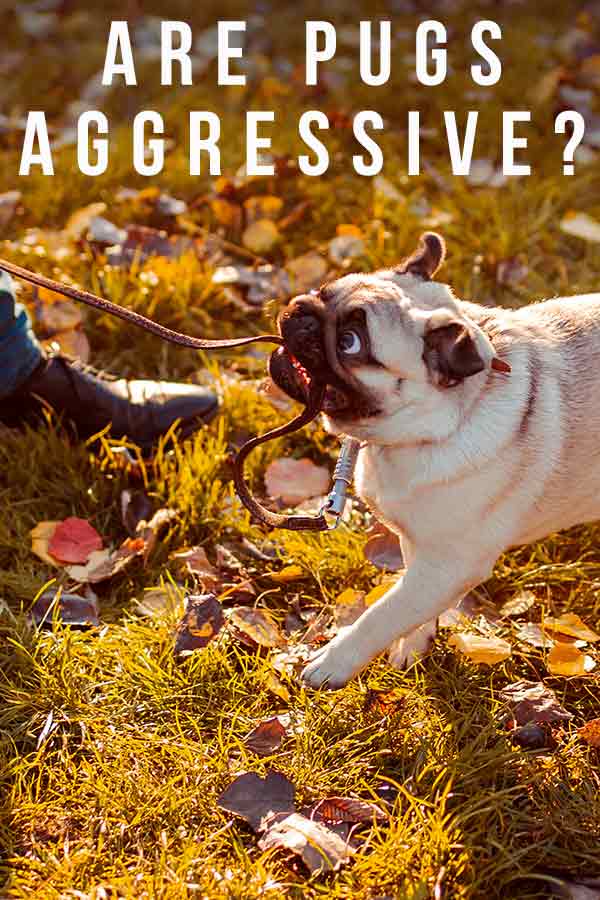
Pugs are not regarded as an aggressive dog breed. Throughout history, their only purpose has been to serve as companions and lapdogs. Aggressive individuals would be unsuited to this. And only the most placid individuals would be used for breeding new generations. However, all dogs can learn to react aggressively in specific situations. So diligent training and socialization is important to raise a well-mannered Pug.
Contents
- What makes a Pug likely to behave aggressively
- Are male pugs more aggressive?
- Aggression towards other dogs and strangers
- Owner-directed aggression
- How to prevent Pugs behaving aggressively
Pugs are an ancient toy breed – they have graced the laps of rulers and aristocrats for hundreds of years. They are popular for their loyal and affectionate disposition, and human-like facial expressions. But unfortunately, the demand for dogs with increasingly flat faces has created enormous problems with brachycephalic diseases in the Pug breed.
The steep cost of treating these problems often leads to Pugs being surrendered at dog shelters. Once there, they may have difficulty being rehomed. Partly due to needing ongoing medical care, and partly due to adopter anxiety about the risk of aggression in dogs with unknown histories.
So what are the odds of a Pug behaving aggressively? Let’s start by looking at what triggers aggressive behavior.
What Makes Pugs Aggressive?
All dogs are capable of acting aggressively. Their wild ancestors would have relied on it in order to survive. And those instincts haven’t been lost, even in lovable lap dogs like Pugs.
There are a few risk factors which are known to make some dogs more likely to behave aggressively than others.
Several studies have reported that male dogs across many breeds are more likely to use aggression than female dogs. This is likely to be because male dogs are programmed to roam more widely in search of mates, and thus encounter more threats.
Older dogs are also more likely to reach aggressively than younger dogs. This can be a result of pain due to health problems linked to old age. Or due to panic and confusion caused by cognitive degeneration (dementia).
Lack of general obedience training, and using punishment for aggressive behavior also increases the likelihood of dogs behaving aggressively. But more than anything, aggression in dogs is a learned response to threatening experiences in their past.
Which means Pugs are more likely to react aggressively towards very specific triggers, rather than towards everything generally.

Are Pugs Aggressive To Other Dogs?
Aggression between Pugs who live together is uncommon, but it has been documented. Lots of dogs become reactive towards other dogs if they have an unpleasant experience which creates a fear response in them next time.
This kind of reactivity is sometimes very particular, and directed only at other dogs of the same breed, shape or color. Specificity means aggression towards other dogs is not a good predictor of aggression towards people. Or vice versa.
Pugs can also form aggressive relationships with other dogs they live with. The most common type of aggression between cohabiting dogs is possessive aggression (resource guarding).
When this happens, it is usually the newest member of the household, or the younger dog of a pair who acts aggressively towards the other.
Are Pugs Aggressive To Strangers?
All dogs are more likely to behave aggressively towards strangers than people they already know. Smaller dogs, including Pugs, are also more likely to display stranger-directed aggressiveness than larger breeds. But good socialisation before 12 weeks old reduces the probability of Pugs being aggressive towards strangers.
Puppy classes are a good way to achieve this, and there is an observable decrease in aggression towards strangers among dogs who attend them. Socialisation works by creating a positive association with meeting new people for your dog.
Dogs who are confident that meeting a new person is going to be a happy and rewarding experience are less likely to react with fearful aggression.
Are Pugs Aggressive Towards Their Family?
Pugs are famous for being sweet and affectionate to their human families. They can learn to react aggressively if their family use physical punishments on them though.
Surprisingly, one study found that dogs (generally, not just Pugs) who attended obedience classes were also more likely to be aggressive towards their family.
However, the researchers suggested that this was actually because people are more likely to enrol their dog in an obedience class if they’re already worried about signs of aggression.
Additionally, rescue dogs are also more likely to be aggressive towards their families. This could be due to their new family unwittingly triggering fear responses which were created before they came home.
An experienced behaviorist can help pinpoint the reasons for family-directed aggression, and plan a strategy for overcoming it.
Are Pugs Safe With Children?
Dogs are more likely to bite children from their own family if they disturb them while they’re sleeping, or interrupt them while they’re eating or playing with a favorite toy. They’re more likely to bite unfamiliar children if they come into the dogs home (rather than out on a walk for example).
Dogs which bite children often have an underlying health condition causing them pain, or an anxiety disorder. All dogs should always be supervised with all children. No matter how peaceful, trustworthy or reliable you think either one might be.
How To Stop A Pug From Biting
Aggression in Pugs is usually a learned response to past experiences – typically upsetting ones which make Pugs fearful next time, and like they need to defend themselves.
Luckily, we have enormous power and control to shape our dog’s experiences, so that they don’t learn to respond aggressively!
These steps will help prevent aggressive behavior in Pugs:
- Socialize them widely as puppies.
- Start obedience training from puppyhood.
- Use positive reinforcement techniques – punishing aggression will make it worse!
- Introduce new dogs to the household in a careful and controlled fashion.
- Learn to recognize fearful body language and don’t ignore it.
What won’t work
There’s a common misconception that many unwanted behaviors in dogs – especially male dogs – can be stopped by neutering. In fact, neutering isn’t linked to reduced aggression toward strangers or other dogs.
With one exception – this study found that male dogs neutered or spayed between 7 and 12 months old are significantly more likely to behave aggressively to strangers.
Puppy biting
A quick note on Pug puppy biting. Many puppies go through a relentless biting stage. It feels like they’re determined to sink their teeth into you at any opportunity.
During this period, it can often feel like the biting is so bad, that there must be something wrong with your puppy.
Maybe they have a built in character flaw which is going to make them aggressive for their whole life?
But, this kind of biting is a normal way for puppies to explore their environment, play together (it doesn’t hurt nearly so much through a protective fur coat!) and soothe the aches and pains of teething.
Are Pugs Aggressive?
So there you have it. Pugs are not typically considered an aggressive breed, but they are capable of aggression.
Usually they will only react aggressively to specific triggers, and behaving aggressively in one situation is not a reliable predictor of aggression in other situations. Fortunately there are lots of things Pug parents can do to prevent aggressive behavior altogether.

Amber says
I have a 2-year-old male pug that got fixed when he was a year old he is the most lovable puppy with my husband and I our children and grandchildren but let anybody else come to the house including children other than my grandchildren and he wants to attack him he gets very aggressive if I have him out he likes to ride in a shopping cart and he’s fine with people coming up to him except for kids he’s never had a bad experience with a child I’ve had him since he was 8 weeks old do not understand where the aggression comes from any helpful hints would be appreciated
Anitaflanagan says
My pug wilber has one eye i have seen him be very aggessive to anyone that gets close to my truck, gas attendee, drive up windows, just gets out of controll wont stop till we pull away .when people come to visit he fine till they go out the door then he attacks the sliing door goes crazy growling attackig the door then runs to a window he can see out if and races back and forth to door and window just growling and attacking, dont know why he goes crazy but there is no controllong ihim.
Jenna says
I have a very sweet and affectionate pug. He loves people coming to the house and loves to snuggle. However, there are a few instances that cause him to be aggressive. Such as cutting his nails or when he is scared (loud noises). When this happens my response use to be to comfort him but then he may feel trapped or something like that because this is the only instance where he bites and bites HARD. I don’t know how to help his fears or soothe the aggression when it comes out 🙁